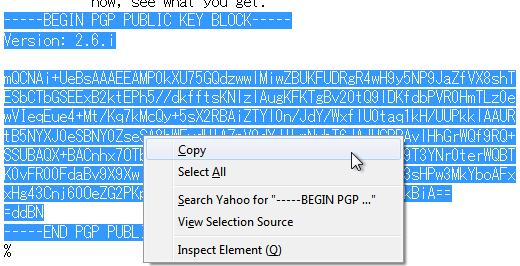Create ASCII-Armored Exports of the New Public Keys The last step is to create export files of the new public keys so they can be uploaded to a public keyserver. In my case, I pasted the contents of the file into the form on the MIT PGP keyserver. This article will guide you through the process of generating public and private keys for encrypting emails. None of your form values or generated keys will leave your browser. The primary Select the PGP Keys Control box. A free, light and easy to use PGP tool. After the key pair is generated usually we will export the public key and send it to our partners. Generate PGP Keys. And it generate private and public keys in armored ASCII format such as.BEGIN PGP PUBLIC KEY BLOCK- Version: BCPG v1.32.
The OpenPGP signer has the fully qualified class name: org.signserver.module.openpgp.signer.OpenPGPSigner.
Overview
The OpenPGP signer can sign arbitrary data and produces an OpenPGP (RFC#4880) detached signature in binary or ASCII armored form or a cleartext signature.
Note that this type of signer does not use X.509 certificates. The OpenPGP public key can instead be obtained from the worker's status output. Additionally, the generate CSR functionality allows adding a user ID to the public key and storing the new public key in the PGPPUBLICKEY worker property.
For step-by-step setup instructions, see Setting up OpenPGP Signer.
Available Properties
| Property | Description |
|---|---|
| DIGEST_ALGORITHM | OpenPGP Hash Algorithm to use with the signature. Possible values are numeric or textual OpenPGP Hash Algorithms. Examples: 'SHA256', '10'. Optional. Default: 'SHA256'. |
| DETACHEDSIGNATURE | Property specifying if a detached signature should be used or otherwise a clear-text signature. Examples: 'true', 'false'. Required. |
| RESPONSE_FORMAT | Format of the response. Either binary or ASCII armored. Examples: 'BINARY', 'ARMORED'. Optional. Default: 'ARMORED'. For clear-text signatures (i.e. DETACHEDSIGNATURE=false) only 'ARMORED' is a valid choice. |
| SELFSIGNED_VALIDITY | The number of seconds the key is valid for after its creation. This property is used when a certification is added to the key so to extend the current validity, set a higher value and perform the certification again. An empty value or zero means that the key does not expire (default). Optional. Default: (empty). |
| PGPPUBLICKEY | Property for storing the latest OpenPGP public key in ASCII armored form after adding user IDs / certifications to it. Remember to store the updated public key in this property so that the current user IDs are kept when new ones are added later on. Optional. Default: (empty). |
| GENERATE_REVOCATION_CERTIFICATE | Setting this property to true, switches the behavior of the generate CSR functionality to not add user ID / certification but instead generate an OpenPGP revocation certificate. Optional. Default: 'false'. The idea is to only switch this to true temporarily, generate the revocation certificate and then switch it back to false. The header for the PGP public key block, |
The OpenPGP signer has the fully qualified class name: org.signserver.module.openpgp.signer.OpenPGPSigner.
Overview
The OpenPGP signer can sign arbitrary data and produces an OpenPGP (RFC#4880) detached signature in binary or ASCII armored form or a cleartext signature.
Note that this type of signer does not use X.509 certificates. The OpenPGP public key can instead be obtained from the worker's status output. Additionally, the generate CSR functionality allows adding a user ID to the public key and storing the new public key in the PGPPUBLICKEY worker property.
For step-by-step setup instructions, see Setting up OpenPGP Signer.

Available Properties
| Property | Description |
|---|---|
| DIGEST_ALGORITHM | OpenPGP Hash Algorithm to use with the signature. Possible values are numeric or textual OpenPGP Hash Algorithms. Examples: 'SHA256', '10'. Optional. Default: 'SHA256'. |
| DETACHEDSIGNATURE | Property specifying if a detached signature should be used or otherwise a clear-text signature. Examples: 'true', 'false'. Required. |
| RESPONSE_FORMAT | Format of the response. Either binary or ASCII armored. Examples: 'BINARY', 'ARMORED'. Optional. Default: 'ARMORED'. For clear-text signatures (i.e. DETACHEDSIGNATURE=false) only 'ARMORED' is a valid choice. |
| SELFSIGNED_VALIDITY | The number of seconds the key is valid for after its creation. This property is used when a certification is added to the key so to extend the current validity, set a higher value and perform the certification again. An empty value or zero means that the key does not expire (default). Optional. Default: (empty). |
| PGPPUBLICKEY | Property for storing the latest OpenPGP public key in ASCII armored form after adding user IDs / certifications to it. Remember to store the updated public key in this property so that the current user IDs are kept when new ones are added later on. Optional. Default: (empty). |
| GENERATE_REVOCATION_CERTIFICATE | Setting this property to true, switches the behavior of the generate CSR functionality to not add user ID / certification but instead generate an OpenPGP revocation certificate. Optional. Default: 'false'. The idea is to only switch this to true temporarily, generate the revocation certificate and then switch it back to false. The header for the PGP public key block, |